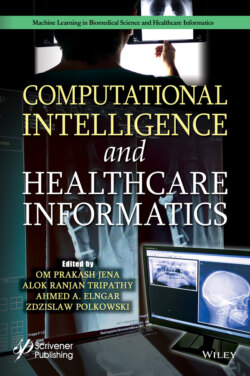Читать книгу Computational Intelligence and Healthcare Informatics - Группа авторов - Страница 4
List of Table
Оглавление1 Chapter 1Table 2.1 Details of ChestX-ray14 dataset.Table 2.2 Comparison of different deep learning models.Table 2.3 Comparison of models on the basis of AUC score for 14 chest pathologie...Table 2.4 Comparison of DL models on the basis of different performance metrics.Table 2.5 Models with hardware used and time required for training.
2 Chapter 5Table 5.1 Dataset description collected from PhysioNet 2016 challenge.Table 5.2 Accuracies for conventional spectrogram generation based on various fe...Table 5.3 Accuracies for various spectrogram generation techniques for WLD featu...Table 5.4 Accuracies for different types of feature extraction method by Mel-spe...Table 5.5 Comparison of proposed work with the related work.
3 Chapter 6Table 6.1 Experimental data sets description.Table 6.2 Comparative study of Hamming Loss of proposed (at 20% reduction) with ...Table 6.3 Comparative study of One-Error of proposed (20% reduction) with ML-KNN...Table 6.4 Comparative study of average precision of proposed (20% reduction) wit...Table 6.5 Experimental result 1: Hamming Loss ↓.Table 6.6 Experimental result 2: One-Error ↓.Table 6.7 Experimental result 3: Average Precision ↑.
4 Chapter 7Table 7.1 Information regarding Pima Indian diabetes dataset.Table 7.2 Confusion matrix.Table 7.3 Outcomes of all eight classification hypotheses on PIDD using 5-fold C...Table 7.4 Performance of all eight classification hypotheses on PIDD using 7-fol...Table 7.5 Performance of all eight classification hypotheses on PIDD using 10-fo...
5 Chapter 8Table 8.1 Grid search hyperparameter tuning of ensemble classifier with hyperpar...Table 8.2 Random search hyperparameter tuning of ensemble classifier with hyperp...Table 8.3 UCI heart disease dataset properties.Table 8.4 Performance evaluation measure of the proposed model.Table 8.5 The outcomes of random forest (RF) before and after applying grid sear...Table 8.6 The performance of AdaBoost (AB) classifier before and after applying ...Table 8.7 The performance of gradient boosting (GB) classifier before and after ...
6 Chapter 9Table 9.1 Healthcare simulation instances.Table 9.2 Clinical characteristics of surgical patients treated for hematologica...Table 9.3 Misclassification—Confusion matrix for bi-LSTM model.Table 9.4 Misclassification—Confusion matrix for LR model.Table 9.5 Misclassification—Confusion matrix for RF model.
7 Chapter 10Table 10.1 Truth table.Table 10.2 Application of cellular automata in health sciences.Table 10.3 Cellular automata modeling in health sciences.Table 10.4 Deep learning applications in health informatics.
8 Chapter 11Table 11.1 COVID-19 dataset attributes in an abbreviated form [15, 21].Table 11.2 Sample of range-wise classification of attributes [15, 21].Table 11.3 Classification of correlation values [11].Table 11.4 Correlation between variables (predictor vs. response).Table 11.5 Straight line trend with regression coefficients.Table 11.6 Sample of frequency count of variables.Table 11.7 Maximum number of rule generation based on support values 20%, 30%, 4...Table 11.8 Some interesting rules for COVID-19 dataset.Table 11.9 Performance assessment of the proposed model.Table 11.10 Performance of the proposed model.Table 11.11 Country-wise performance comparison of actual and predicted output b...Table 11.12 Country-wise performance comparison of actual and predicted output b...Table 11.13 Risk classification of output parameters.Table 11.14 Sample of risk-wise categorization of countries based on output para...
9 Chapter 12Table 12.1 Scale for comparing alternatives.Table 12.2 Number of comparisons.Table 12.3 Comparisons of precision, recall, and F-measure for various sentiment...Table 12.4 Comparisons of precision, recall, and F-measure for various sentiment...Table 12.5 Time consumption of various sentiment analysis schemes (Satu, Md Shah...
10 Chapter 13Table 13.1 Discretized features represented using fuzzy variables.Table 13.2 Different severity condition.Table 13.3 Calculation of severity factor.Table 13.4 Performance measure with patients samples.
11 Chapter 14Table 14.1 Classification report (in percent).
12 Chapter 18Table 18.1 COVID-19 dataset “KaTrace” description.Table 18.2 Relationship established in neo2j tool.Table 18.3 Centrality for the knowledge graph.Table 18.4 District-wise parent and child count of patients attended congregatio...Table 18.5 Comparing the death count of a few districts.Table 18.6 Survival status and gender count.Table 18.7 Statistical inference.Table 18.8 Data values of tests conducted.Table 18.9 Parent and child relationship count.Table 18.10 Spread count of a few patients.Table 18.11 Oversea patient’s details.
13 Chapter 20Table 20.1 IA agreement.Table 20.2 Distribution of corpus in HMT and ABDT.Table 20.3 Category-wise evaluation results of HMT and ABDT.
